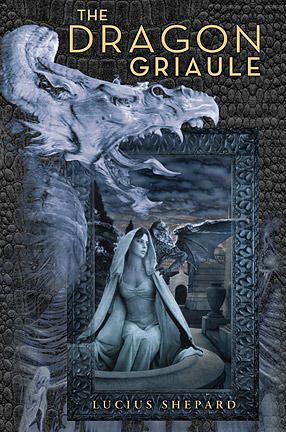Lucius Shepard’s classic story “The Man Who Painted the Dragon Griaule” introduced the world to Griaule, a huge (as in six thousand feet long) paralyzed dragon who shapes the lives of the people living around, on and in some cases inside him by means of the malignant mental energy that seems to be his only remaining power.
Meric Cattanay, the main character of this story, is ready to do what no one else has been able to achieve: he offers to kill off Griaule once and for all. His method is unusual: he proposes to get rid of the dragon by painting him: if the inhabitants of the city that grew in the shadow of the dragon are willing to advance him a small fortune, he will spend several decades painting a huge mural on the dragon, slowly killing it with the toxins in his paints.
Lucius Shepard revisited Griaule’s world (“separated from this one by the thinnest margin of possibility”) on several occasions in the two decades or so since the original story was published, resulting in a handful of brilliant novelettes and novellas that approach the dragon and his influence from various perspectives and in different periods: “The Scalehunter’s Beautiful Daughter,” “The Father of Stones,” “Liar’s House,” and “The Taborin Scale.” Thanks to Subterranean Press, all of these are now available for the first time in one volume: The Dragon Griaule. To put the icing on the cake, the book also includes a long new Griaule novella (or possibly a short novel) entitled The Skull, as well as a set of story notes by the author giving background about the stories and often the circumstances in which they were written. In other words, you may want to check out this book even if you’ve managed to track down all the other stories.
The human cast for each of these stories is different. Their common thread is Griaule, the monster who dominates the world even in paralysis. The sheer size of the dragon highlights the insignificance of the tiny human ants scrabbling around his hide. It’s almost as if they’re living on or near a volcano: at the mercy of an uncontrollable force that’s always there in the background, even if they occasionally manage to pretend otherwise. This creates a dark, even fatalistic atmosphere: people come and go with their romances, dreams and petty rivalries, but Griaule perseveres.
Because the human characters change from story to story, they often feel insignificant and incidental, but that doesn’t mean they’re uninteresting. Lucius Shepard has one of the sharpest pens in the genre, and he’s in top form in this set of stories. He has the ability to give a character shape in just a few phrases by acerbically picking out one or two traits and then mercilessly hammering them down in clean, biting prose. At one point he describes someone’s trophy wife as “sunglasses by Gucci and make-up by Sherwin-Williams.” There’s often some dissonance between the surreal atmosphere of the stories and the razor-sharp descriptions of people’s emotions and actions as they wander around in the haze of Griaule’s atmosphere. It makes for a bizarre but highly enjoyable reading experience as Shepard traces the lives of several people who get sucked into Griaule’s orbit over the years.
But what does it all mean? Until I read this book, I always assumed that Griaule was meant to be a symbol of fantasy as a genre, the dragon being one of its oldest tropes and one that’s been beaten to death in too many stories in the past. In The Dragon Griaule, we don’t get your typical fire-breathing magical lizard but instead a paralyzed monster, although it’s still exuding its influence and shaping the world around it. Then an artist proposes to kill it. With art. If anything, it reminded me of a less religion-inspired version of James Morrow’s Towing Jehovah, in which God’s two mile long corpse has fallen into the Atlantic and must be towed towards the Arctic for internment. Seemed like the start of a solid interpretation—until I read the author’s story notes, which explicitly connect Griaule to the Reagan Administration, “a baleful monster beaming out his vindictive thought and shaping us to its will.” While the political theme was there all along in retrospect, it definitely becomes most pronounced in the newest addition to the canon, The Skull, which breaks through the thin margin of possibility to bring Griaule explicitly into the reality of South American politics.
So, maybe not a commentary on the state of the fantasy genre after all? It just goes to show that there’s more food for thought in each of these stories than you’ll find in most full length novels. Each of them really deserves a review as long as this one, making The Dragon Griaule simply a brilliant collection. Subterranean Press has to be commended for collecting them all in one volume, because they’re hard to track down individually but work together so incredibly well. Highly recommended.
Stefan Raets reads and reviews science fiction and fantasy whenever he isn’t distracted by less important things like eating and sleeping. His website is Far Beyond Reality.










